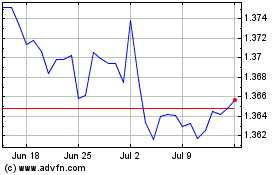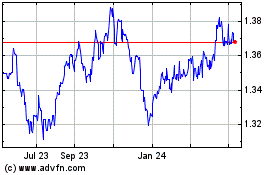Australia GDP Rises 1.1% On Quarter In Q4
February 28 2017 - 4:44PM
RTTF2
Australia's gross domestic product expanded a seasonally
adjusted 1.1 percent on quarter in the fourth quarter of 2016, the
Australian Bureau of Statistics said on Wednesday.
That exceeded forecasts for an increase of 0.8 percent following
the 0.5 percent contraction in the third quarter.
On a yearly basis, GDP advanced 2.4 percent - again beating
forecasts for 2.0 percent and up from 1.8 percent in the three
months prior.
Final consumption expenditure was up 0.7 percent on quarter and
2.8 percent on year, while gross fixed capital formation gained 2.6
percent on quarter but dipped 0.1 percent on year.
The GDP chain price index picked up 2.9 percent on quarter and
4.9 percent on year.
The terms of trade spiked 9.1 percent on quarter and 15.6
percent on year.
Real net disposable income gained 2.9 percent on quarter and 6.8
percent on year.
Household final consumption expenditure contributed 0.5
percentage points and public capital formation contributed 0.3
percentage points to growth.
Private non-financial corporations Gross operating surplus
increased by 16.5 percent.
Compensation of employees decreased 0.5 percent, but was 1.5
percent higher through the year.
Growth was recorded in 15 out of 20 industries. Strongest growth
was observed in mining, agriculture, forestry and fishing, and
professional scientific and technical services, each industry
contributed 0.2 percentage points to GDP growth.
Household final consumption expenditure contributed 0.5
percentage points to GDP growth. Net exports contributed 0.2
percentage points.
Public and private capital formation both contributed 0.3
percentage points this quarter after both detracted from GDP growth
last quarter.
Nominal GDP grew 3.0 percent to be 6.1 percent higher through
the year. Real net national disposable income increased 2.9 percent
for the quarter.
Also on Wednesday, the Australian Industry Group said that the
manufacturing sector in Australia continued to expand in February,
and at a sharply faster pace with a Performance of Manufacturing
Index score of 59.3.
That marks a large jump from 51.2 in January, and it moves
further above the boom-or-bust line of 50 that separates expansion
from contraction.
It also marks the highest index reading since May 2002.
Individually, new orders, sales, production and employment all
saw solid gains.
"The surge in February builds on a recovery from the sluggish
performance in the third quarter of last year and marks a fifth
month of expansion," said Australian Industry Group chief executive
Innes Willox.
US Dollar vs CAD (FX:USDCAD)
Forex Chart
From Mar 2024 to Apr 2024

US Dollar vs CAD (FX:USDCAD)
Forex Chart
From Apr 2023 to Apr 2024
